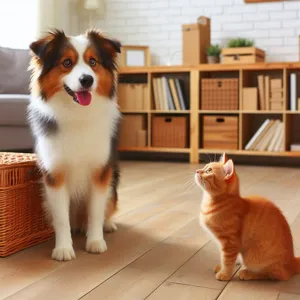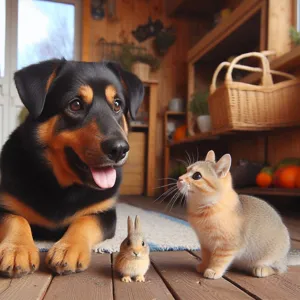Introducing a new dog into a home with a resident cat can feel like navigating a delicate dance—one filled with excitement, anxiety, and the promise of new friendships.
As pet parents, we often dream of harmonious household dynamics where our furry friends coexist peacefully. However, the realities of pet personalities, territorial instincts, and varied temperaments can complicate this vision. In “Paws and Claws: The Ultimate Guide to Introducing Your new Dog to Your Resident Cat,” we delve into the essential steps and strategies to ensure a smooth and successful introduction. From understanding your cat’s signals to choosing the right approach for your dog, this guide will equip you with the knowledge and tools to foster a loving relationship between your pets. Prepare to embark on a journey of patience and understanding, as we pave the way for a joyful and peaceful multi-pet household!
1. Understanding Canine and Feline Behaviors

When it comes to introducing a new dog to your resident cat, the first step is to understand the fundamental differences in their behaviors and instincts. Dogs and cats are wired differently, which can lead to misunderstandings and, at times, conflict.
Dogs are pack animals by nature, often seeking companionship and approval from their human family members. They communicate through barks, growls, and body language, displaying emotions like excitement and anxiety openly. A wagging tail, for instance, typically signals happiness, while raised hackles can indicate alertness or aggression. This enthusiasm, however, can sometimes be misinterpreted by cats, who tend to be more solitary and territorial creatures.
Cats, on the other hand, are more nuanced in their communication. They rely heavily on body language, vocalizations, and scent marking to convey their feelings. A cat may arch its back or hiss when feeling threatened, and their slow-blinking gaze is a sign of trust and affection. While they can be social, cats prefer to maintain a sense of control over their environment, making them more cautious around newcomers.
Understanding these differences is crucial for a successful introduction. For instance, a dog’s playful energy might be interpreted as a threat by a cat, causing the latter to retreat or lash out. Conversely, a cat’s subtle signals could be lost on an eager dog, leading to frustration and confusion.
By recognizing these distinct behaviors, you can create a harmonious environment for both pets. Prepare to facilitate their introductions with patience, ensuring that each animal feels safe and secure. This understanding will not only ease the transition but also help foster a positive relationship between your new dog and your resident cat as they navigate their shared space.
2. Preparing Your Home for the Introduction
When it comes to introducing a new dog to your resident cat, preparation is key. Setting the stage for a harmonious relationship between your furry friends can make all the difference in ensuring a smooth transition. Start by creating a designated space for your new dog. This should be a comfortable area equipped with their own bed, toys, and food and water bowls. It’s essential that your dog has a safe haven where they can retreat, especially in those first few days when everything feels new and overwhelming.
Next, focus on the cat’s territory. Cats are creatures of habit, and sudden changes can be stressful for them. Make sure your cat has access to their favorite spots, whether it’s a high perch, a cozy nook, or their litter box. It’s wise to ensure that these areas are off-limits to the dog, at least until they’re more familiar with each other. Consider using baby gates or barriers to create safe zones where your cat can observe the new addition without feeling threatened.
Additionally, take the time to remove any items that could become potential hazards during their initial meetings. Keep small toys, food, and anything valuable out of reach to prevent any unwanted altercations. It’s also a good idea to have scratch posts or climbing towers available for your cat, as these can provide both a distraction and an escape route if they feel overwhelmed.
Lastly, scent plays a crucial role in how animals perceive one another. Before the introduction, swap bedding or toys between the two to help them become familiar with each other’s scent. This simple step can ease tension and create a sense of familiarity before they ever meet face to face.
By taking the time to thoughtfully prepare your home for the introduction, you set the foundation for a peaceful coexistence between your new dog and your resident cat, fostering an environment of safety and comfort for both pets.
3. Choosing the Right Time to Introduce Them

When it comes to introducing your new dog to your resident cat, timing can make all the difference. The right moment can set the stage for a harmonious relationship, while the wrong timing can lead to stress and anxiety for both pets. Start by considering your cat’s routine and natural behavior. Cats are creatures of habit, often preferring a calm and predictable environment. Introducing a new dog during a time of day when your cat is most relaxed—perhaps after a morning nap or during their evening wind-down—can yield better results.
Additionally, think about the dog’s energy level. If you have a high-energy puppy who’s eager to play and explore, introducing them during a quiet moment might overwhelm your cat. Opt for a time when your dog is calm, perhaps after a long walk or play session, so they are more likely to be relaxed and less inclined to chase or bark at your cat.
Also, consider any significant changes in your household. If you’ve recently moved, experienced changes in family dynamics, or if your cat is going through a stressful period, it might be best to wait until things have settled. A chaotic environment can heighten anxiety for both pets, making introductions more difficult.
By carefully choosing the right time to introduce your new dog to your resident cat, you create a more favorable environment for initial interactions, helping to foster a peaceful coexistence from the start. Remember, patience is key; rushing the process can lead to resistance and fear, so take your time to ensure both animals feel safe and comfortable during this crucial transition.
4. Initial Separation: Creating Safe Spaces
When introducing a new dog to your resident cat, the initial separation is crucial for a smooth transition and harmonious coexistence. This phase is all about creating safe spaces where both pets can feel secure and comfortable as they adjust to each other’s presence.
Start by designating specific areas of your home for each pet. Your cat should have its own sanctuary—perhaps a cozy nook high up on a shelf or a quiet room where it can retreat with its favorite toys and bedding. Cats often feel safest when they can observe their surroundings from an elevated position, so consider setting up a perch or a cat tree. This space should be off-limits to the new dog, allowing your cat to explore and relax without the stress of an unfamiliar canine nearby.
Meanwhile, the dog should have its own designated area, equipped with a comfortable bed, toys, and food and water bowls. This is where the dog can unwind and feel secure, especially during the initial introductions. Utilize baby gates to create a physical barrier while still allowing them to see and hear one another. This way, they can slowly acclimate to each other’s scents and sounds without the immediate pressure of face-to-face interactions.
During this period of separation, it’s essential to maintain a calm atmosphere. Use positive reinforcement techniques to reward both pets for calm behavior when they are near the barrier. This will help them associate each other with positive experiences, making future interactions less daunting.
Remember, patience is key. Allow your cat and dog to set the pace for their introductions. As they become more comfortable with each other’s presence, you can gradually increase their time together under supervision. Creating these safe spaces not only protects your pets during this transitional period but also lays the foundation for a peaceful and loving relationship in the future.
5. The Scent Exchange: Getting Familiar with Each Other

The scent exchange is a crucial step in the process of introducing your new dog to your resident cat. Animals rely heavily on their sense of smell to gather information about their environment and the creatures within it. By facilitating a scent exchange, you can help both your dog and cat become familiar with each other’s presence before they meet face-to-face.
Start by collecting items that have the scent of each animal. For your cat, this could be their favorite blanket, a toy, or even a piece of clothing that carries their unique scent. For your dog, consider using a towel or toy they frequently use. Place these items in the other animal’s space—your cat’s blanket in the dog’s area, and vice versa. This allows them to explore and investigate the foreign scents at their own pace, without the pressure of an immediate introduction.
While they are sniffing these items, observe their reactions. You might notice your cat becoming curious or your dog showing interest. It’s important to reassure them during this process, offering gentle words or treats to create a positive association with the new scent. Continue this exchange over several days, gradually swapping more items and increasing the time they spend with the scents.
This initial scent exchange sets the stage for a smoother transition when they finally meet. By the time you do introduce them face-to-face, both your dog and cat will have a basic familiarity with each other, reducing the likelihood of fear or aggression. This step is all about creating a sense of comfort and curiosity—two essential elements for a harmonious household where paws and claws can coexist peacefully.
6. Gradual Introduction: First Impressions
When it comes to introducing your new dog to your resident cat, the first impressions are crucial. A gradual introduction can set the tone for a harmonious household and help prevent potential conflicts between your furry friends. Start by allowing each pet to get accustomed to the other’s scent before they meet face-to-face. You can achieve this by swapping bedding or using a soft cloth to gently rub each animal and then letting the other sniff it. This subtle exchange can help ease the tension and curiosity that often accompanies such introductions.
Next, create a safe space for your cat—a retreat where they can observe the new dog from a distance without feeling threatened. This space could be a high perch, a separate room, or even a cozy cat tree where they can feel secure. Allow your dog to explore their new surroundings, but keep them on a leash during the initial encounters to maintain control over the situation.
Once both pets seem calm and comfortable with each other’s scents, it’s time for the first face-to-face meeting. Choose a quiet, neutral space free from distractions, and keep the dog on a leash while allowing the cat to roam freely. Monitor their body language closely: your dog should be calm and non-aggressive, while your cat might display a mix of curiosity and caution. Be prepared to intervene if either pet shows signs of stress or aggression.
Keep these initial meetings brief and positive, gradually increasing their duration as they become more comfortable with each other. Reward both pets with treats and praise for calm behavior, reinforcing the idea that being around each other is a positive experience. Remember, patience is key; rushing the process can lead to anxiety and hostility, making it harder for your pets to coexist peacefully. With time, care, and gradual introductions, you’ll pave the way for a loving and balanced relationship between your dog and cat.
7. Supervised Meetings: Tips for a Successful Encounter

Introducing a new dog to your resident cat can be a delicate process, and supervised meetings play a crucial role in ensuring a harmonious relationship between the two. Taking the time to facilitate these encounters with care can set the tone for their future interactions. Here are some tips to make those initial meetings successful.
First and foremost, choose a neutral space for the introduction. This prevents either pet from feeling territorial and allows both the dog and cat to approach the situation with less anxiety. A room where neither has established a strong claim is ideal. Ensure the dog is on a leash during these first meetings to maintain control while allowing the cat the freedom to explore at her own pace.
Create a calm environment by minimizing distractions. Keep the noise level low, and consider using calming aids like pheromone diffusers or sprays designed to ease pet stress. Before the meeting, engage both pets in some form of relaxation—play with the dog to expend some energy and offer treats or engage your cat in a quiet activity to help her feel more secure.
When it’s time for the introduction, allow the cat to enter the space first. Cats often prefer to take the lead, and letting her explore the area on her terms can help her feel more comfortable. Once she seems at ease, gradually bring in the dog, keeping him on a loose leash. Watch for body language—an erect tail, flattened ears, or hissing from the cat indicates discomfort, while a relaxed posture and slow movements signal curiosity.
Be patient and prepared for a range of reactions. It’s normal for the dog to be excited and curious, while the cat may display wariness or even defensive behavior. If either pet becomes overly stressed, don’t hesitate to separate them and try again later. Short, positive sessions are more beneficial than long, tense encounters. Reward both pets with treats for calm behavior during the meetings, reinforcing the idea that good things happen when they are together.
Lastly, gradually increase the duration of these supervised meetings as they grow more comfortable with each other. Over time, you can introduce elements like toys and treats to encourage positive interactions, paving the way for a peaceful coexistence in your home. Remember, every pet is unique, and some may take longer than others to adjust. With patience and persistence, you’ll create a welcoming environment where your new dog and resident cat can thrive together.
8. Reading Body Language: Signs of Stress or Comfort
When introducing a new dog to your resident cat, understanding body language is crucial in ensuring a smooth transition. Both animals communicate their feelings non-verbally, and being attuned to their signals can help you gauge their comfort levels and reduce stress.
For your dog, watch for signs such as a wagging tail, relaxed ears, and an open mouth—these indicate a friendly disposition. However, if the tail is tucked, ears are pinned back, or the dog is panting excessively, it may be feeling anxious or threatened. Similarly, a dog that is fixated on the cat, with stiff body posture, could be exhibiting predatory behavior, which requires immediate intervention.
On the other hand, your cat’s body language is equally telling. A cat that feels secure will display soft, slowly blinking eyes, a relaxed body, and a tail held high. If you notice your cat hissing, swatting, or puffing up its fur, it’s clearly feeling stressed or defensive. Cats may also seek higher ground when they feel threatened, so observing where your cat chooses to position itself can provide insight into its comfort level during the introduction process.
By keenly observing these signs, you can tailor your approach to ensure both your new dog and resident cat feel safe and secure. Create a calm environment, allowing each pet to retreat to their safe spaces if needed, and always supervise their interactions until you’re sure they’ve established a sense of mutual respect and comfort. This careful attention to body language can make all the difference in helping your pets coexist peacefully.
9. Managing Jealousy and Competition for Attention
When introducing a new dog to a resident cat, managing jealousy and competition for attention becomes a crucial aspect of ensuring a harmonious household. Both pets seek love and validation, and it’s natural for them to feel threatened when they perceive a shift in their owner’s affections. To navigate this delicate situation, it’s essential to establish a balanced approach that fosters a sense of security for both your furry companions.
Start by being mindful of how you distribute your attention. Dogs, with their exuberance and eagerness to please, often demand more immediate interaction. This can inadvertently lead to feelings of neglect in your cat. To prevent this, set aside dedicated time for each pet. Designate moments in your day for one-on-one play, cuddles, or simply quiet companionship. This way, both your dog and cat will feel valued and loved, reducing the potential for jealousy.
Create a routine that incorporates both pets without making either feel sidelined. For instance, during playtime with your dog, allow your cat to be nearby, engaging them with toys or treats. This not only helps your cat feel included but also allows them to observe the dog in a non-threatening environment. Gradually, they may become more comfortable with each other’s presence.
Additionally, be vigilant about body language. Cats can be particularly sensitive to changes in their environment and may react defensively to what they perceive as competition. If you notice your cat displaying signs of stress—such as hiding, hissing, or swatting—intervene calmly. Redirect their attention with a favorite toy or treat, reinforcing a positive association with the dog’s presence.
Lastly, consider providing separate spaces for your pets. Having distinct areas for each can help alleviate tension and give both pets a safe retreat when they need a break from each other. With time, patience, and consistent attention, you can help your new dog and resident cat coexist peacefully, transforming potential rivalry into a bond that enriches your home.
10. Establishing Boundaries: Safe Zones for Each Pet
When introducing a new dog to your resident cat, establishing boundaries is crucial for fostering a harmonious household. Both pets need their own safe spaces where they can retreat and feel secure, especially as they navigate this new dynamic. Safe zones not only give your cat a sense of control but also help your dog understand where they are welcome and where they should tread lightly.
Start by designating specific areas in your home for each pet. For your cat, this could be a high perch, such as a cat tree or a shelf, where they can observe the new dog from a distance. Cats often feel safest when they have the option to escape or hide, so ensure they have access to cozy nooks or rooms equipped with their favorite toys, litter box, and food bowls.
For your dog, create a comfortable space that reflects their needs. A crate or a designated dog bed in a quiet corner can serve as their sanctuary. Encourage your dog to view this area as their own by rewarding them with treats and praise whenever they settle down there. This will help them learn to respect the boundaries you’ve set and create a positive association with their safe zone.
During the initial introductions, keep the dog on a leash and allow the cat to explore the dog’s space from a safe distance. If the new dog gets too excited or aggressive, gently redirect them back to their safe zone. Use baby gates or screen doors to create physical barriers that allow both pets to see and hear each other without direct contact, helping them to acclimate at their own pace.
Establishing these boundaries is not just about physical space; it also involves setting clear rules for behavior. Consistently reinforce commands with your dog, such as “leave it” or “stay,” whenever they approach the cat’s area. This will teach them to respect the cat’s boundaries and reduce the likelihood of any aggressive or overly playful interactions.
By prioritizing safe zones for both your dog and cat, you create an environment that supports their comfort and well-being, making the transition smoother for everyone involved. With patience and consistency, you’ll be on your way to a peaceful coexistence between your furry companions.
11. Training Techniques for a Smooth Transition
Introducing a new dog to your resident cat can be a delicate process, but with the right training techniques, you can ensure a smoother transition for both furry friends. Start by establishing a controlled environment where both animals can feel safe. This means creating separate spaces for your cat and dog, allowing them to acclimate to each other’s scents before any face-to-face meetings.
Utilize positive reinforcement training for your new dog. Reward them with treats and praise when they display calm behavior in the presence of your cat. This helps to create a positive association with the cat rather than triggering a chase instinct. Likewise, reinforce your cat’s positive behavior when they remain calm—offering treats or affection can go a long way in encouraging them to feel secure.
Consider employing basic commands like “sit,” “stay,” and “leave it” with your dog, as these can be invaluable during initial introductions. When the time comes for them to meet, keep your dog on a leash and allow your cat to roam freely, controlling the pace of the encounter. If the dog becomes too excited or fixates on the cat, gently redirect their attention or remove them from the situation to avoid overwhelming your cat.
It’s also essential to manage your dog’s energy levels. Regular exercise and mental stimulation can help reduce hyperactivity, making your dog less likely to chase your cat. Incorporate training sessions, playtime, and walks into your routine to give your dog an outlet for their energy.
Finally, remain patient throughout the process. Each animal will adjust at their own pace, and it may take time for them to feel comfortable in each other’s presence. By employing consistent training techniques and offering plenty of love and reassurance to both your dog and cat, you can foster a harmonious household where both pets thrive together.
12. Monitoring Their Relationship Over Time
Introducing a new dog to your resident cat is just the beginning of a journey that requires ongoing attention and care. Monitoring their relationship over time is crucial to ensuring that both pets feel safe, secure, and happy in their shared environment. After the initial introductions, it’s important to observe their interactions closely—even when they seem to be getting along well.
Watch for body language cues from both the dog and the cat. Signs of stress in cats can include flattened ears, hissing, or retreating to high perches, while dogs may display overexcitement, barking, or even possessiveness over toys and space. Create a safe space for your cat where they can escape if things get a bit too overwhelming. Cat trees, shelves, or even separate rooms can serve as great sanctuaries.
Regularly assess their behavior with each other. Are they playing together, or is there tension when they share the same space? It may take weeks or even months for them to establish a comfortable relationship. Be patient and allow them to set the pace. If you notice any signs of aggression or anxiety, it may be necessary to go back a few steps in your introduction process, giving each pet more time to adjust.
Additionally, consider scheduling regular check-ins during playtime or feeding. Supervise these moments to ensure that they remain positive. Incorporate joint training sessions, where both pets can learn to follow commands together, fostering a sense of teamwork and harmony.
By continuously monitoring your pets’ relationship over time and being responsive to their needs, you’ll not only help them coexist but also foster a unique bond that can enrich both their lives. With patience, love, and careful observation, your new dog and resident cat can become the best of friends, sharing your home—and your heart—for years to come.
13. Dealing with Backward Steps: What to Do if Things Go Wrong
Introducing a new dog to a resident cat can sometimes feel like navigating a minefield, and despite your best preparations, things may not go as smoothly as hoped. It’s essential to remember that setbacks are a natural part of the process, and understanding how to deal with these backward steps can make all the difference in achieving harmony in your home.
First, observe the dynamics closely. If your cat is exhibiting signs of distress—such as hissing, swatting, or hiding—it’s crucial to take a step back. This reaction doesn’t mean you’ve failed; rather, it’s an indication that your cat needs more time and space to adjust. Reinforce the idea that both pets should feel safe in their environment. Create separate spaces where each animal can retreat to feel secure. For your cat, this could be a high perch or a secluded nook, while your dog may benefit from a cozy crate or a designated area where they can relax without feeling overwhelmed.
Next, consider revisiting the introduction process. Sometimes, it’s necessary to slow down and go back to square one. Reintroduce them using scent swapping—allow your cat and dog to explore each other’s bedding or toys to familiarize themselves with one another’s scent without direct interaction. Gradually progress to supervised meetings, using a leash for the dog and allowing the cat to approach at their own pace.
Additionally, positive reinforcement can be a powerful tool in redirecting their behaviors. Rewarding both your dog and cat with treats and praise during calm interactions can reinforce good behavior. Similarly, if either pet displays unwanted behavior, gently redirect them without punishment. For instance, if your dog gets too excited and lunges towards the cat, redirect their attention to a toy or command.
Lastly, patience is key. Each pet has its own timeline for adjustment, and it’s important to remain calm and understanding throughout the process. If tensions persist, consider consulting a professional animal behaviorist who can provide tailored advice to help harmonize your household. Remember, with time, patience, and a bit of strategy, your dog and cat can learn to coexist peacefully, transforming your home into a happy haven for both paws and claws.
14. The Importance of Patience and Consistency
When it comes to introducing a new dog into a home with a resident cat, patience and consistency are your greatest allies. This transition period can be filled with excitement, anxiety, and a whirlwind of emotions for both animals, and rushing the process can lead to unnecessary stress and conflict. Understanding that each pet has their own unique personality and comfort level is crucial.
Patience means allowing your new dog to acclimate to their surroundings at their own pace. Some dogs may be eager to explore, while others might feel overwhelmed and seek refuge. Similarly, your cat may react with curiosity, fear, or even territorial behavior. It’s vital to observe their reactions and provide a safe space for both pets to retreat to when they feel anxious.
Consistency, on the other hand, involves establishing a routine that reinforces positive interactions and behaviors. Regular feeding times, designated play sessions, and structured training can help your pets feel secure in their new dynamics. Use consistent commands and cues for both animals, and reward them for calm behavior when they are near each other.
Additionally, consider using scent swapping as a gentle introduction technique. Allow your dog and cat to become familiar with each other’s scents before any face-to-face meetings. You can do this by swapping their bedding or using a soft cloth to rub one pet and then letting the other sniff it.
Remember, the goal is to create a harmonious household where both your new dog and resident cat can thrive. By embracing patience and maintaining consistency, you’re not just managing their introduction; you’re nurturing the relationship that will ultimately lead to a peaceful, loving environment for all.
15. Celebrating Success: Bonding Activities for Your Pets
Once your new dog and resident cat have settled into their routine and shown signs of comfort with each other, it’s time to celebrate their progress with some bonding activities. These activities not only reinforce their growing relationship but also create joyful experiences that can help solidify their companionship.
Start with interactive play sessions that involve both pets. Choose toys that can be enjoyed together, like a feather wand for your cat that your dog can chase or a soft ball that encourages both to engage. Supervised play allows them to associate positive feelings with each other’s presence, turning what might have been a tense situation into a fun adventure.
Another great bonding activity is shared training sessions. Teach your dog simple commands or tricks, and encourage your cat to join in by rewarding both with treats. Cats may not fetch like dogs, but you can train them to respond to their name or perform small tricks like “high five.” This shared experience can create a sense of teamwork and build a positive atmosphere in your home.
Consider utilizing scent enrichment to deepen their connection. Allow your dog to sniff your cat’s blanket or toys, and vice versa, in a controlled manner. This can help both pets become familiar with each other’s scents, reinforcing their bond.
Lastly, don’t underestimate the power of relaxation time spent together. Create a cozy space with a soft bed or blanket where they can lounge side by side. Play calming music or use pet-safe pheromone diffusers to create a serene environment. This low-pressure setting encourages your pets to relax in each other’s company, helping to foster a sense of security and friendship.
Celebrating these milestones with bonding activities not only enriches their lives but also strengthens the connection between your new dog and resident cat, paving the way for a harmonious household filled with love and companionship.
In conclusion, successfully introducing a new dog to your resident cat requires patience, understanding, and a well-thought-out plan. By following the steps outlined in our ultimate guide, you can create a harmonious home where both pets feel safe and comfortable. Remember, each animal has its own personality and pace, so take the time to observe their interactions and adjust your approach as necessary. With love, consistency, and a little bit of effort, your furry friends can learn to coexist peacefully, enriching each other’s lives in the process. We hope this guide has provided you with the insights and confidence to embark on this exciting journey, and we can’t wait to hear about the heartwarming bond that blossoms between your new dog and your beloved cat! Happy pet parenting!






